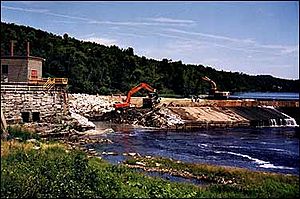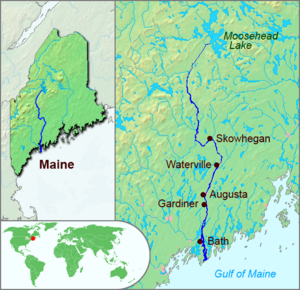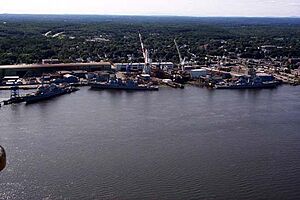Edwards Dam facts for kids
Quick facts for kids Edwards Dam |
|
|---|---|

Edwards Dam removal, 1999
|
|
| Location | Augusta, Maine, USA |
| Coordinates | 44°19′28″N 69°46′17″W / 44.3245°N 69.7714°W |
| Opening date | 1837 |
| Demolition date | 1999 |
| Dam and spillways | |
| Impounds | Kennebec River |
| Height | 24 feet (7.3 m) |
| Length | 917 feet (280 m) |
The Edwards Dam was a large structure built across the Kennebec River in Augusta, Maine, USA. It was about 40 miles (64 km) from the Atlantic Ocean. Built in 1837 from wood and concrete, it was 917 feet (280 m) long and 24 feet (7.3 m) high. This dam is famous because it was the first time the U.S. government made a dam owner remove a hydroelectric dam against their wishes.
The dam originally had a special path for fish, called a fish ladder, but it was destroyed by a flood soon after it was built. The dam itself broke badly in 1839, 1846, and 1855. In 1999, the Federal Energy Regulatory Commission (FERC) decided not to let the dam keep operating. This was because it was causing too much harm to the environment. The dam was then removed, which freed up a 17-mile (27 km) part of the Kennebec River. This part of the river had been covered by the dam's water for 162 years.
Contents
Where Was the Edwards Dam?
The Edwards Dam was built on the Kennebec River. This river flows 150 miles (240 km) south from Moosehead Lake. It drains about one-fifth of the state of Maine. Most of the land around the river is smooth and has some towns and cities. Many small and large lakes are also part of the river's system. Important cities along the Kennebec include Skowhegan, Waterville, Augusta, Gardiner, and Bath. The river's water near Augusta is affected by the ocean's tides.
A Look Back: The Dam's Story
The River Before the Dam
Before the Edwards Dam was built, the Kennebec River was very important for fish. Many Atlantic salmon and other ocean fish came here to lay their eggs. The area near the river's mouth, called the estuary, had many islands and salt marshes. These were perfect places for young fish like sturgeon and salmon to grow up.
Building the Dam and Its Effects
In 1837, the Edwards Dam was built across the Kennebec River. It was made of wood and concrete. The dam was 917 feet (280 m) wide and 25 feet (7.6 m) tall. The water held back by the dam created a lake (reservoir) that stretched 17 miles (27 km) upstream. This lake covered about 1,143 acres (4.6 km²).
Right after the dam was built, the number of fish that swam upstream to lay eggs dropped sharply. This included fish like Atlantic salmon, river herring, striped bass, and sturgeon. The local fishing businesses were hit the hardest. They completely disappeared by 1867, just 30 years after the dam was built. Fish ladders were put in to help fish get past the dam, but they didn't work. This caused the fish that travel between the ocean and fresh water to almost vanish.
However, some small groups of fish still lived below the dam. A business that caught and raised American eels started up because other fish populations were declining.
River Pollution Problems
The Edwards Dam was first built to help paper mills. These mills used a lot of wood from the area. But these paper mills also caused a lot of pollution in the river. This pollution led to the disappearance of the last striped bass. Towns grew along the Kennebec River because of these paper mills.
By the 1950s, so much raw sewage was flowing into the river that it smelled terrible. Logs from cutting trees upstream also choked the river, making the water still and dirty. The amount of oxygen in the water dropped very low. This caused many fish to die in 1947, 1957, 1963, and 1965. People even said that the windows of the Maine State House, which was near the river, had to be kept closed in summer because of the river's bad smell.
Why the Dam Was Removed
The Edwards Dam's operating permit ran out in 1997. The dam owners wanted to get a new one. But the Federal Energy Regulatory Commission (FERC) said no. This was the first time in U.S. history that the government refused to renew a dam's license. This decision was based on a 1986 federal law. This law says that FERC must consider how much a dam harms the environment compared to how much electricity it makes.
The Edwards Dam did not meet this rule. FERC gave the dam owners two choices:
- Remove the dam.
- Spend $8.9 million to build a working fish ladder. They would also need to spend another $1 million to help fix the environmental damage.
The Edwards Dam was not used for controlling floods, watering farms, or making a lot of electricity. It only produced a tiny amount of Maine's electricity needs, about 3.5 megawatts. Only four people earned money from the dam. Because of this, it made more sense to take the dam down.
The Bath Iron Works and the Kennebec Hydro Developers Group, who owned other dams upstream, gave $7.25 million to help remove the Edwards Dam. In return, plans for fish paths at their upstream dams were put on hold.
How the Dam Was Taken Down
Removing the Edwards Dam happened in several steps. First, workers built a temporary gravel wall, called a cofferdam, about 60 feet (18 m) long upstream of the Edwards Dam. Then, they used explosives to break down the 60-foot section of the dam that was protected by this temporary wall. This temporary dam was removed on July 1, 1999. This lowered the water level in the reservoir by half.
Next, they built a 200-foot (61 m) cofferdam to remove another section of the dam in the same way. After this section was gone, the Kennebec River flowed freely again. This was the first time in 162 years! The remaining 657 feet (200 m) of the dam were removed by hand. The broken pieces of the dam were used to fill in the old power plant's water intake. They also used the material to turn the dam site into a new park.
The River's Comeback
After the dam was removed, the river looked a bit messy at first. The riverbanks were bare, and the water was muddy for about 17 miles (27 km) downstream. But the river's ecosystem is now healing itself.
Fish like smallmouth bass, which were brought into the river, might struggle. This is because the returning striped bass like to eat young smallmouth bass. We will also see more raptors like ospreys, bald eagles, herons, cormorants, and kingfishers.
People also benefit from the dam's removal. The river now has rapids again, and native fish species have returned. This allows for many fun activities like canoeing, kayaking, whitewater rafting, and fishing. It's estimated that the increase in sport fishing alone brings in about $48 million each year!




